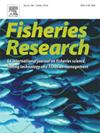Optimizing per vessel hour capture efficiency for rare, heterogeneously distributed fishes: Invasive grass carp Ctenopharyngodon idella in the Sandusky River
IF 2.2
2区 农林科学
Q2 FISHERIES
引用次数: 0
Abstract
Natural resources management is often concerned with conserving rare-native or controlling rare-invasive fishes. Informing and assessing conservation and control efforts frequently requires information from captures. When little is understood about spatial and temporal fish distributions, captures can be infrequent and costly. If successful management depends on effective management response, optimizing for efficiency may be the difference between success and failure. We compared per vessel hour capture efficiencies for invasive grass carp (Ctenopharyngodon idella) between two methods: electrofishing-only (electrofishing) and in combination with a trammel net (combination). Capture and effort information including 174 captures from 1853 capture attempts from 1706 total hours of effort in the Sandusky River, OH, USA from 2020–2023 was used to fit a generalized linear model. Captures were allowed to vary by river kilometer, month, and year to account for unequal capture rates and effort. Captures were offset by total vessel hours or the count of independent efforts to compare methods that prioritize detection at a single location (e.g., combination) to methods that prioritize exploiting more locations (e.g., electrofishing). Including trammel nets was intended to increase single site detection, but we found that electrofishing-only was at least 2.4x more efficient (catch per vessel hour) than when combined with a trammel net with no significant difference in catch per removal effort. Complex methods intended to increase single site detection may reduce the number of efforts completed. Therefore, overall capture efficiency and total capture numbers for rare fish may be increased through methods that prioritize per-hour efficiency.
优化每艘船小时捕获稀有、分布不均的鱼类的效率:桑达斯基河入侵草鱼Ctenopharyngodon idella
自然资源管理通常涉及保护稀有本地鱼类或控制稀有入侵鱼类。通报和评估保护和控制工作经常需要捕获的信息。当对鱼类的空间和时间分布知之甚少时,捕捞可能不频繁且代价高昂。如果成功的管理取决于有效的管理反应,那么对效率的优化可能是成功与失败的区别。我们比较了两种方法对入侵草鱼(Ctenopharyngodon idella)的每船小时捕获效率:纯电钓(电钓)和与网网结合(组合)。利用2020-2023年美国俄亥俄州桑达斯基河(Sandusky River) 1706小时总努力中1853次捕获尝试中的174次捕获和努力信息拟合广义线性模型。捕获量允许随河流的公里、月和年而变化,以解释不平等的捕获率和努力。捕获量被总船小时数或独立工作次数抵消,以比较优先在单个位置(例如组合)进行检测的方法与优先开发更多位置(例如电钓)的方法。包括束缚网的目的是增加单个站点的检测,但我们发现,与与束缚网结合使用时相比,仅电钓的效率(每艘船小时的渔获量)至少高出2.4倍,而每次清除努力的渔获量没有显著差异。旨在增加单位点检测的复杂方法可能会减少完成的工作量。因此,通过优先考虑每小时效率的方法,可以提高对稀有鱼类的总体捕获效率和总捕获数量。
本文章由计算机程序翻译,如有差异,请以英文原文为准。
求助全文
约1分钟内获得全文
求助全文
来源期刊

Fisheries Research
农林科学-渔业
CiteScore
4.50
自引率
16.70%
发文量
294
审稿时长
15 weeks
期刊介绍:
This journal provides an international forum for the publication of papers in the areas of fisheries science, fishing technology, fisheries management and relevant socio-economics. The scope covers fisheries in salt, brackish and freshwater systems, and all aspects of associated ecology, environmental aspects of fisheries, and economics. Both theoretical and practical papers are acceptable, including laboratory and field experimental studies relevant to fisheries. Papers on the conservation of exploitable living resources are welcome. Review and Viewpoint articles are also published. As the specified areas inevitably impinge on and interrelate with each other, the approach of the journal is multidisciplinary, and authors are encouraged to emphasise the relevance of their own work to that of other disciplines. The journal is intended for fisheries scientists, biological oceanographers, gear technologists, economists, managers, administrators, policy makers and legislators.
 求助内容:
求助内容: 应助结果提醒方式:
应助结果提醒方式:


